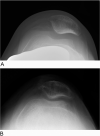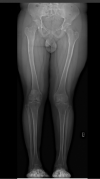Patellar Dislocation and Fracture After Medial Patellofemoral Ligament Reconstruction in a Patient With Osteogenesis Imperfecta
- PMID: 35355651
- PMCID: PMC8929215
- DOI: 10.31486/toj.21.0025
Patellar Dislocation and Fracture After Medial Patellofemoral Ligament Reconstruction in a Patient With Osteogenesis Imperfecta
Abstract
Background: Patellar instability is a common orthopedic condition in the pediatric population. Many factors contribute to patellar instability, including trochlear dysplasia. However, patellar instability and its treatments are not well documented in the literature for patients with osteogenesis imperfecta. Case Report: After medial patellofemoral ligament (MPFL) reconstruction, a 17-year-old male with osteogenesis imperfecta had a patellar dislocation that resulted in a patellar fracture. The patient subsequently had a revision of his MPFL reconstruction, and at 2½ years postoperation has had no episodes of recurrent patellar instability. Conclusion: The combination of bone fragility, trochlear dysplasia, and strength of the allograft used for MPFL reconstruction compared to the patient's bone strength led to dislocation and patellar fracture. Research into alternative methods for patellar fixation and postoperative physical therapy protocols for patients with osteogenesis imperfecta is needed. Special considerations must be made for this patient population.
Keywords: Osteogenesis imperfecta; patella; patellar dislocation; patellar ligament.
©2022 by the author(s); Creative Commons Attribution License (CC BY).
Figures





Similar articles
-
Factors Affecting the Outcomes of Double-Bundle Medial Patellofemoral Ligament Reconstruction for Recurrent Patellar Dislocations Evaluated by Multivariate Analysis.Am J Sports Med. 2015 Dec;43(12):2988-96. doi: 10.1177/0363546515606102. Epub 2015 Oct 4. Am J Sports Med. 2015. PMID: 26435448
-
Does degree of trochlear dysplasia and position of femoral tunnel influence outcome after medial patellofemoral ligament reconstruction?Am J Sports Med. 2014 Mar;42(3):716-22. doi: 10.1177/0363546513518413. Epub 2014 Jan 23. Am J Sports Med. 2014. PMID: 24458241
-
Clinical Outcomes After Isolated Medial Patellofemoral Ligament Reconstruction for Patellar Instability Among Patients With Trochlear Dysplasia.Am J Sports Med. 2018 Mar;46(4):883-889. doi: 10.1177/0363546517745625. Epub 2018 Jan 3. Am J Sports Med. 2018. PMID: 29298083
-
Recurrent patellar dislocations: trochleoplasty improves the results of medial patellofemoral ligament surgery only in severe trochlear dysplasia.Knee Surg Sports Traumatol Arthrosc. 2019 Nov;27(11):3599-3613. doi: 10.1007/s00167-019-05469-4. Epub 2019 Mar 22. Knee Surg Sports Traumatol Arthrosc. 2019. PMID: 30903220
-
Imaging of Patellofemoral Instability.Clin Sports Med. 2021 Oct;40(4):693-712. doi: 10.1016/j.csm.2021.05.007. Clin Sports Med. 2021. PMID: 34509206 Review.
References
-
- Hennrikus W, Pylawka T. Patellofemoral instability in skeletally immature athletes. J Bone Joint Surg Am. 2013;95(2):176-183. - PubMed
-
- Weeks KD 3rd, Fabricant PD, Ladenhauf HN, Green DW. Surgical options for patellar stabilization in the skeletally immature patient. Sports Med Arthrosc Rev. 2012;20(3):194-202. - PubMed
Publication types
LinkOut - more resources
Full Text Sources
